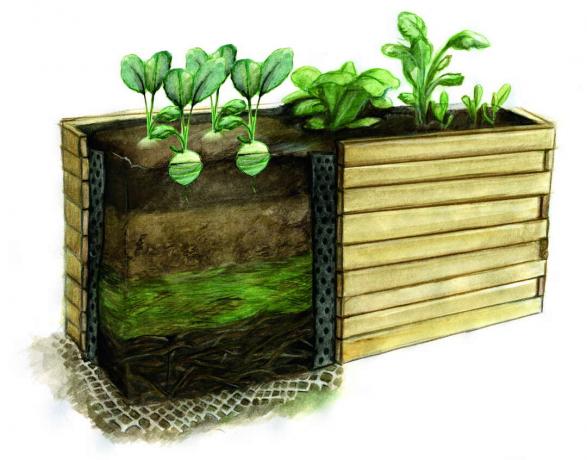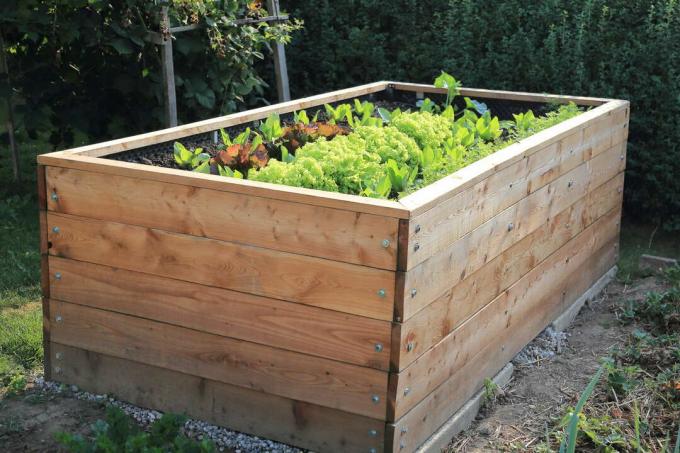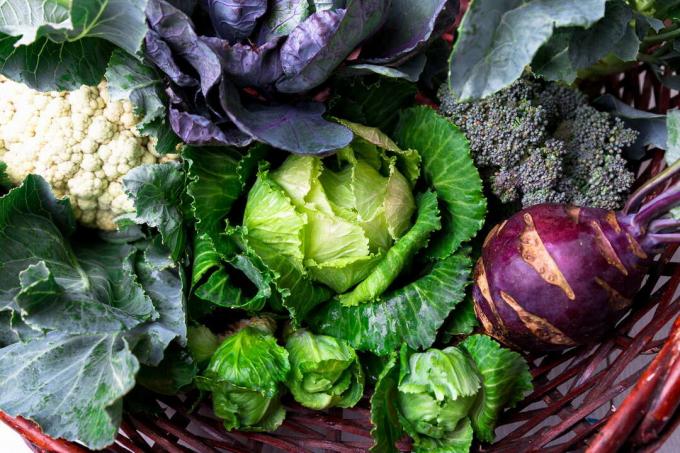Autumn is here and the raised bed is empty? It doesn't have to be - we'll show you how you can plant your raised bed in the fall.

Raised beds are currently on the rise. No wonder, after all, the practical beds are not only easy on the back, but also offer numerous advantages for growing vegetables. But did you know that you can still easily grow numerous types of vegetables in raised beds in autumn? In fact, some types of vegetables can be wonderfully cultivated in a raised bed even if it would be too cold in a normal bed. We will show you why autumn cultivation in raised beds works so well and which types of vegetables are particularly suitable for autumn cultivation.
contents
- Planting a raised bed in autumn: that's what's behind it
- Planting raised beds in autumn: tips and tricks to extend the season
- Planting raised beds in autumn: suitable types of vegetables
- Planting raised beds in autumn: overview of suitable types of vegetables
- Planting raised beds in autumn: green manure instead of vegetables
Planting a raised bed in autumn: that's what's behind it
It's not just the shorter days that make things difficult for our plants in autumn: frost and moisture in particular bring many plants to an early end. But here the raised bed has a decisive advantage: On the one hand, the water drains much faster through the drainage layer in the raised bed, so that vegetables and co. do not get wet feet. On the other hand, the various layers of soil continue to rot in autumn and release energy in the form of heat - so the raised bed has a built-in heater for the cold days. This ensures that the plants are only affected by frost and cold much later than their counterparts in the field and can grow much longer.

Planting raised beds in autumn: tips and tricks to extend the season
But even in the raised bed it gets too cold for the plants at some point - fortunately there are a few tips and tricks on how to extend the season a little: One An excellent way to keep the temperature in the raised bed comfortable even during the first night frosts in autumn is to use a foil tunnel to cover Under the foil, the heat collects so effectively that you can grow vegetables well into the winter. Only regular airing on sunny days is mandatory, otherwise the risk of fungal infection increases. A cold frame or greenhouse attachment also works according to this principle and is ideal for the Autumn cultivation (many manufacturers already have suitable, quick and easy to assemble solutions for their raised beds in the Range). However, mulching individual types of vegetables or laying out fleece can also increase the temperature by up to 5 °C effect: This small temperature difference alone has an enormous effect on plant growth and ensures better Harvest.

Planting raised beds in autumn: suitable types of vegetables
If you still want to harvest something in autumn, you usually fall back on the classic autumn vegetable varieties. Sown in the summer, these types of vegetables ripen well into the fall and also feel right at home in the raised bed. Especially cabbages like Chinese cabbage, broccoli or Brussels sprouts are perfect for the raised bed, but also carrots or fennel benefit from their new home.
In autumn, of course, the typical winter vegetables are grown, which otherwise actually have a permanent place in the bed. The best way to do this is to grow the seedlings indoors and later plant them as young plants. This can also be done in September or October without any problems, but you have to reckon with the fact that the harvest will not take place until spring. Kale, spinach and Co. ensure full raised beds in winter, after all they are robust in defying cold and frost.
tip: So that the vegetables in your raised bed feel good, you should use a high-quality and drip-free organic soil like ours Plantura organic tomato & vegetable soil use. In this way you can ensure that your plants have the best possible conditions and that a rich harvest will soon be forthcoming.
But not only autumn and winter vegetables can still be harvested easily and uncomplicatedly so late in the year: Almost all salads, as well as leeks and radish are perfect for the bed because they have a very short growing season. This way they can be harvested before the days get too short and the first severe frosts appear. However, with all vegetables, they should never be harvested when the temperature is below zero – not only can this harm the plants, but it also causes the leaves to become mushy as they thaw will.

Planting raised beds in autumn: overview of suitable types of vegetables
Here you will find an overview of all types of vegetables that deserve a place in the raised bed in autumn.
- All types of cabbage, including Chinese cabbage (Brassica rapa subsp. pekinensis), broccoli (Brassica oleracea var. italiana), Brussels sprouts (Brassica oleracea var. gemifera), Kohlrabi (Brassica oleracea var. gonglyodes) and Kale (Brassica oleracea var. sabellica)
- All types of lettuce, are particularly suitable arugula (Eruca vesicaria ssp. sativa), radicchio (Cichorium intybus var. foliosum), endive (Cichorium endivia) and frisee (Cichorium endivia var. crispum)
- Leek (Alium ampeloprascum)
- radish (Raphanus sativus)
- celery (Apium graveolens)
- parsley (Peterselinum crispum)
- spinach (Spinacia oleracea)
- chard (Beta vulgaris subsp. vulgaris)
- carrots (Daucus carota subsp. sativus)
- fennel (Foeniculum vulgare)

Planting raised beds in autumn: green manure instead of vegetables
Would you rather do something good for your raised bed and don't necessarily need fresh vegetables in winter? Then green manure is just the right thing: instead of leaving the bed empty in winter or growing vegetables in it, you can also cover your raised bed with hardy legumes (Fabacea) plant as green manure. The main advantage of these plants is that they bind nitrogen in the soil with the help of nodule bacteria and thus allow the soil to regenerate naturally in winter. At the same time, they also protect the soil from the effects of the weather and erosion, to which a "bare" bed would otherwise be exposed.
Especially clover (trifolium) and sainfoin (Onobrychis) have turned out to be good green manure tried and tested and are not only useful, but also look good. In early spring, the cultivated legumes are then dug under - here they also serve as valuable fertilizer. With this winter pampering program, your bed will be perfectly prepared for the new gardening season in spring.
More about green manure and Plant raised bed find out in this article.

For more raised bed inspiration, visit our Pinterest page:


